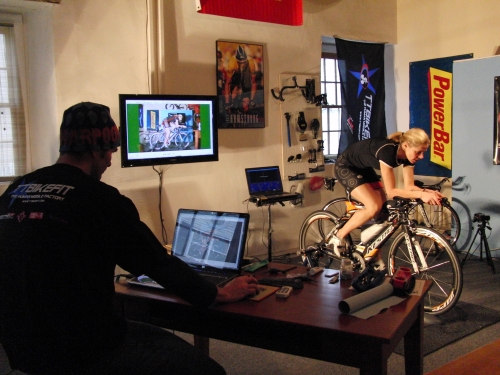
Get Fit, Get Fast!
I recently did a presentation about Training and Racing Power at the TriFitLab run by TTBikeFit.com It was a good presentation (I’ve done better), but what always interests me is not what I do or whom I’m speaking with but the questions that come from the audience. Instead of leaving those answers information at the clinic with the 35 folks who attended, I want to post answers here in a space where everyone can learn from them.
1. What power training software do I recommend? The standard software that comes with each powermeter is pretty budget. I recommend that people use WKO Plus by TrainingPeaks.com. It’s simply the industry standard and a great place to start. If you are looking for a more predictive tool, you can refer to RaceDay software. Finally, if you want a robust free software package, you can consider using SportTracks.
Depending on the software you choose, it can cost money, but most are under $100. I view it simply as the cost of doing business and using your powermeter. A powermeter is nothing more than very expensive cadence sensor unless you actually take the data, analyze it and put it into practice. So, absolutely use that software, so important.
2. Does 30 minutes of hard riding equal 3 hours of easy riding? People really asked a lot of questions about my statement where I said that if I can earn the same training stress in an hour-long hard ride < ?> that I could learn in two hours in an easy ride…then why would I ever chose to ride those two hours. For busy athletes on a fixed schedule, intensity is the biggest tool in your arsenal. While there’s no one “best way” to build fitness, there are certain ways that are better for your life.
There was a specific question one gentleman had around adaptation, development of capillaries, the ability in the body to transport oxygen and so on, as all of those development happen at lower aerobic levels — and aren’t you essentially short-changing yourself by training at a higher intensity. At the end of the day, all of the work that we do below our functional threshold is really aerobic, and it’s just a function of how many of your slow-twitch and fast-twitch fibers you’re recruiting to get the work done.
The work that you do in zone three versus zone two or zone one, which are easier, simply recruits more muscles to get that work done. That doesn’t mean that there’s less capillaries developed and that there’s less oxygen being transported. The plumbing is the same. Doing more work you get those same aerobic benefits out of it. Of course, any good training program will have variety. Variety in training will induce adaptation. You also need to explore all of your options, but for the age group triathlete or age group cyclist a plan is only as good as your ability to implement it.
3. Will a powermeter help me on race day? Finally, people asked a lot of questions about using a powermeter as a race execution device, and whether or not triathletes could potentially use a device and use the information gathered to race.
The answer is yes, triathletes absolutely can race off the numbers you generate on a test. On race day, everything that you do is really a percentage of that functional threshold number. And having power in the race can help you eliminate so many of the external environmental things that can only distract you from executing the optimal steady race: competition, hills, etc. The best race is a steady one, and a powermeter can help you do that.
For the roadies, I think that a powermeter is very different on race day. While you should record and review your performance later, in the race itself I think you can use the numbers on the dial as a means to add more depth, more color, more dimensions to the race right now. Traditionally, when you’re in a group or a breakaway, you’ve got to make decisions based on how you feel, and based on the perceived fitness of those around you. That guy looks strong; this guy is not so strong, etc.
With a powermeter, you can see how much in work you’re doing right now, and you can begin to see what the power numbers look on each key section of the course, measuring that number against what you know you can sustain from your training. All of a sudden you can make informed decisions: Can I handle the effort I need to put out on this hill? How much harder do I need to work to separate myself from this group? What does the effort look like when guy number one gets the front versus guy number two? How much harder or how much less harder are we working? Am I getting more of a benefit here, siting second wheel, or do I have more of a benefit here sitting third or four wheel? All of that changes over time, and the power meter gives you the ability to really make quality decisions that can really effect the race and your placing.
Conclusion
While a powermeter is certainly not a cure-all for everything that you do as a triathlete or roadies, it certainly is very specific and detailed tool that can transform the way you approach your training, the way that you build your fitness; both within a given training cycle, but also across the year across multiple years, and ultimately, turn you into a phenomenal racer, helping you leapfrog way ahead on the learning curve, much further than you would have had you not had a powermeter.


Chris Gleason
going faster is a good thing – work works